By S.A.J Shirazi
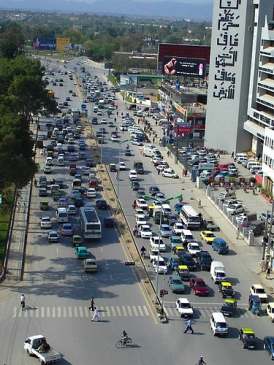 The bustling city of Rawalpindi has a lot more to offer than a traffic mess, broken roads and haze-filled atmosphere. The city’s history spreads over several millennia. Archaeologists believe that a distinct culture flourished on this plateau even 3,000 years ago.
The bustling city of Rawalpindi has a lot more to offer than a traffic mess, broken roads and haze-filled atmosphere. The city’s history spreads over several millennia. Archaeologists believe that a distinct culture flourished on this plateau even 3,000 years ago.
.. Photo to the left is a shot of the Mall, Rawalpindi ..
The archaeological remains found here prove the existence of a Buddhist community contemporary to Taxila, but less celebrated than its neighbour. Historians believe that the ancient city fell victim to the devastation caused by the Huns. The first Muslim invader, Mahmud of Ghazni (979-1030AD), gifted the ruined city to a Gakkhar chief, Kai Gohar. The Gakkhars were a fiercly independent tribe of the Potowar Plateau. The town, however, being in the route of invaders, could not prosper and remained deserted until Jhanda Khan, another Gakkhar chief, restored it and named it Rawalpindi after the village Rawal in 1493.
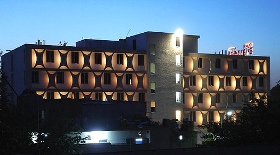 Rawalpindi remained under the rule of the Gakkhars till Muqarrab Khan, the last Gakkhar ruler, was defeated by the Sikhs in 1765.
Rawalpindi remained under the rule of the Gakkhars till Muqarrab Khan, the last Gakkhar ruler, was defeated by the Sikhs in 1765.
.. Photo to the right shows Hotel Shalimar, Rawalpindi ..
The Sikhs invited traders from other places to settle here, which brought the city into the limelight.
Following the British victory over the Sikhs and occupation of Rawalpindi in 1849, the city became a permanent garrison of the British army in 1851. 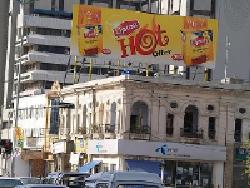 In the 1880s, a railway line to Rawalpindi was laid, and a train service started on January 1, 1886. The need for a railway link arose after Lord Dalhousie made Rawalpindi the headquarters of the Northern Command and the city became the largest military garrison in British India.
In the 1880s, a railway line to Rawalpindi was laid, and a train service started on January 1, 1886. The need for a railway link arose after Lord Dalhousie made Rawalpindi the headquarters of the Northern Command and the city became the largest military garrison in British India.
In 1951, Rawalpindi saw the murder of the first elected prime minister of Pakistan, Liaquat Ali Khan, in Company Bagh, later named after him. Today, Rawalpindi is the headquarters of the Pakistan Army and the Pakistan Air Force.
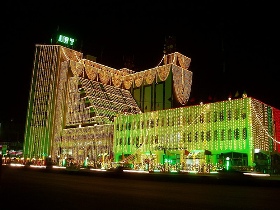 The modern city has everything that one can desire – good eateries, playgrounds and shopping centres. Though many shopping centres have opened all over the city, two main bazaars, Raja Bazaar in the old city and Saddar, which developed as the cantonment bazaar between the old city and the Mall, continue to attract a large number of visitors every day.
The modern city has everything that one can desire – good eateries, playgrounds and shopping centres. Though many shopping centres have opened all over the city, two main bazaars, Raja Bazaar in the old city and Saddar, which developed as the cantonment bazaar between the old city and the Mall, continue to attract a large number of visitors every day.
For a traditional Lahori breakfast, Banni or Purana Qila offers the best siri paiyay, nihari and chanay.
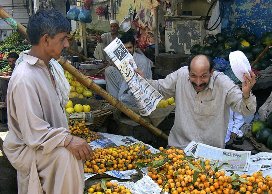 Commercial Market, off main Murree Road, is fast becoming the hub of business activity in the city and besides some good restaurants, one can shop here for quality clothes.
Commercial Market, off main Murree Road, is fast becoming the hub of business activity in the city and besides some good restaurants, one can shop here for quality clothes.
.. Photo to the left shows a merry fruit selles on a Rawalpindi street ..
The crowded alleys of the old city like Purana Qila, Bhabra Bazaar, Lal Kurti, Banni and inner areas of Saddar, are home to many attractions, including ancient Hindu and Sikh temples.
Some of the old houses in these areas, though dilapidated, are a tribute to the master artisans and masons of yesteryears. The beautiful construction and woodwork survive even today, despite the passage of over a century and the fact that no effort has been made by their current owners to preserve these buildings.
 Ayub National Park is located beyond the old Presidency on Jhelum Road, covering about 2,300 acres or 9.3 square kilometres, and has a lake with boating facility, an aquarium, a garden-restaurant and the Play Land.
Ayub National Park is located beyond the old Presidency on Jhelum Road, covering about 2,300 acres or 9.3 square kilometres, and has a lake with boating facility, an aquarium, a garden-restaurant and the Play Land.
.. Photo to the right shows an ancient building in the city called Qutub House ..
Rawalpindi Public Park, located on Murree Road near Shamsabad, was opened to public in 1991. It consists of the Play Land, grassy lawns, a jogging track, fountains and flowerbeds.
The cricket stadium, built in 1992 opposite the public park, has seen some of the world’s top cricket teams play one-dayers and test matches here.
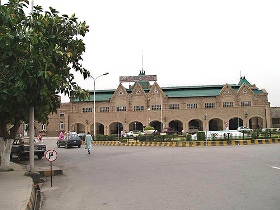 There are many forts and other places of tourist attraction a few kilometres outside the city limits.Rawat Fort is located 17 km east of Rawalpindi, on the Grand Trunk (GT) Road leading to Lahore. Gakkhars built the fort, in the early 16th century.
There are many forts and other places of tourist attraction a few kilometres outside the city limits.Rawat Fort is located 17 km east of Rawalpindi, on the Grand Trunk (GT) Road leading to Lahore. Gakkhars built the fort, in the early 16th century.
.. Photo to the left is the facade of Rawalpindi Railway Station ..
The grave of Gakkhar chief Sultan Sarang Khan is located inside the fort. He died in 1546 AD in a battle against the forces of Sher Shah Suri. Up from the broken steps inside the tomb, is a panoramic view of the plateau and the Mankiala Stupa.
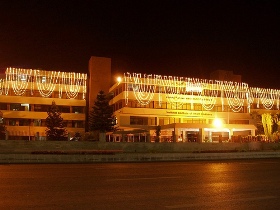 Pharwala Fort is about 40 km from Rawalpindi beyond Lehtrar Road. It is also a Gakkhar fort built in the 15th century on the ruins of a 10th century fort.Mughal emperor Babur conquered the fort in 1519 AD.
Pharwala Fort is about 40 km from Rawalpindi beyond Lehtrar Road. It is also a Gakkhar fort built in the 15th century on the ruins of a 10th century fort.Mughal emperor Babur conquered the fort in 1519 AD.
.. Photo to the right is the National Institute of Heart Diseases, Rawalpindi ..
In 1825, the Sikhs took over the fort. Though crumbling away, it is still an attraction for castle lovers and the artistic.
Rohtas Fort, a UNESCO world heritage site, is 109 km from Rawalpindi. 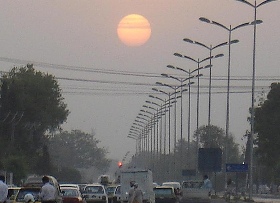 It is located about 6 km southwest of Dina.The fort is one of the most impressive historical monuments in Pakistan. It was built by Afghan ruler Sher Shah Suri between 1540 and 1547 AD. It served as Suri’s fortified base for military operations against the Gakkhars.
It is located about 6 km southwest of Dina.The fort is one of the most impressive historical monuments in Pakistan. It was built by Afghan ruler Sher Shah Suri between 1540 and 1547 AD. It served as Suri’s fortified base for military operations against the Gakkhars.
.. Photo to the left is a sunset view on Peshawar Road, Rawalpindi ..
It was later used by Mughal emperor Akbar and the Sikhs. Within the huge terraced rampart walls with robust bastions and twelve gates, is located another fortress, palaces and ancillary buildings.
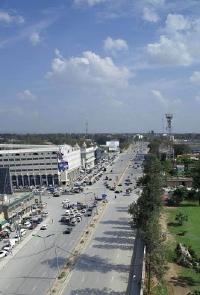 Rawalpindi also served as the interim capital after Islamabad was declared the nation’s new capital in the 1960s and was still being constructed. So the infrastructure was shifted to Rawalpindi from Karachi, the previous capital of Pakistan, and then was moved to Islamabad.
Rawalpindi also served as the interim capital after Islamabad was declared the nation’s new capital in the 1960s and was still being constructed. So the infrastructure was shifted to Rawalpindi from Karachi, the previous capital of Pakistan, and then was moved to Islamabad.
.. Photo to the right is the Mall, Rawalpindi, look east ..
PHOTO CREDITS: Photos for this article have been taken from flickr.com from an album set here. Clicking at individual photos in the article above will also take you to their source website and larger image sizes.



















































As Salam Elikum
Pindi is the heart beat of pakistan. my born is at murree nearst place to pindi for refreshment. my parents came here since there youth and shifted here in last two decades, Pindi spread its arms for all the country fellows, Public Parks, Schools, Stadium and a bundle of refreshing points, specifically its nearst place to islamabad, the heart of pakistan.
AOA
dis is muddassir…my parrents moved to pindi 1987 from karachi….i’ve spent 18 years in pindi in other word i raised in pindi..now i moved to canada but i miss ma pindi i know each n single cornor of pindi….i love my pindi..am in canada for past 3 years now but i can’t forget the wonderful time i had in pindi through all these years……………..PINDI IN MINE…………….
syed waqar shah hamdani
i was born in pindi ,i love pindi,its my home ,now i am settle in australia but i miss pindi every single day ,the best place in entire world ,its heaven for me.
syed waqar shah hamdani
fone no#+61411673059
i like too rawalpindi.i went to the pindi ist time 4 police traning.all the city is so beautiful.i live in lahore but love pindi
Hi
I am Faysal from Sialkot, I like very much Rawal Pindi city, because my beloved and loveable cousin living in this city, however i realy realy like and love of this city,… my specialy place in rawal pindi ( Bani Chowk ) when i will be come pindi firstly i will be go ( Bani Chowk )………… my beloved cousin always Smile….my prayers with you and with your city,,,,
Contact No:
0333-8714661
Regards
Faysal
===================================